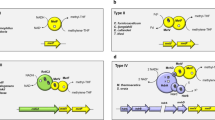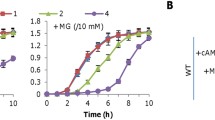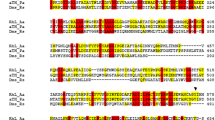Abstract
InEscherichia coli, several terminal reductases catalyze the reduction of S- and N-oxide compounds. We have used mutants missing either the constitutive dimethylsulfoxide (DMSO) reductase,dmsABC, and/or the inducible trimethylamine N-oxide (TMAO) reductase,torA, to define the roles of each reductase. These studies indicated that the constitutive DMSO reductase can sustain growth on DMSO, TMAO, methionine sulfoxide (MetSO), and other N-oxide compounds. Only one inducible TMAO reductase is expressed inE. coli, and this enzyme sustains growth on TMAO but not DMSO or MetSO. Characterization of atorA −, dms−double mutant revealed that adenosine N-oxide (ANO) reductase is specifically required for anaerobic respiration on ANO in this mutant.
Similar content being viewed by others
Literature Cited
Bilous PT, Weiner JH (1985) Proton translocation coupled to dimethyl sulfoxide reduction in anaerobically grownEscherichia coli HB101. J Bacteriol 163:369–375
Bilous PT, Weiner JH (1988) Molecular cloning and expression of theEscherichia coli dimethyl sulfoxide reductase operon. J Bacteriol 170:1511–1518
Bilous PT, Cole ST, Anderson WF, Weiner JH (1988) Nucleotide sequence of thedmsABC operon encoding the anaerobic dimethyl sulfoxide reductase ofEscherichia coli. Mol Microbiol 2:785–795
Bragg D, Hackett NR (1983) Cytochromes of the trimethylamine N-oxide anaerobic respiratory pathway ofEscherichia coli. Biochim. Biophys. Acta 725:168–177
Condon C, Weiner JH (1988) Fumarate reductase ofEscherichia coli: an investigation of function and assembly using in vivo complementation. Mol Microbiol 2:43–52.
Ejin SI, Weissbach H, Brot N (1979) Reduction of methionione sulfoxide to methionine byEscherichia coli. J Bacteriol 139:161–164
Ferguson SJ, Page MD (1990) The functions and biosynthesis of thec-type cytochromes of bacterial respiratory chains with particular reference to autotrophs and the handling of C1 compounds. FEMS Microbiol Rev 87:227–234
Jasin M, Schimmel P (1984) Deletion of an essential gene inEscherichia coli by site-specific recombination with linear DNA fragments. J Bacteriol 159:783–786
Kelly DP, Baker SC (1990) The organosulfur cycle: aerobic and anaerobic processes leading to turnover of C1-sulfur compounds. FEMS Microbiol Rev 87:241–246
Kurihara FN, Satoh T (1988) A single enzyme is responsible for both dimethylsulfoxide and trimethylamine N-oxide respirations as the terminal reductase in a photodenitrifier,Rhodobacter sphaeroides f.s. denitrificans. Plant Cell Physiol 29:377–379
Markwell MA, Haas KSM, Bieber LL, Tolbert NE (1978) A modification of the Lowry procedure to simplify protein determination in membrane and lipoprotein samples. Anal Biochem 87:206–210
Miller JH (1972) Experiments in molecular genetics. Cold Spring Harbor, NY: Cold Spring Harbor Laboratory
Pascal MC, Bierne JF, Chippaux M (1984) Regulation of trimethylamine N-oxide (TMAO) reductase inEscherichia coli: Analysis oftor::Mud` operon fusion. Mol Gen Genet 195:351–355
Sagai M, Ishimoto M (1973) An enzyme reducing adenosine1N-oxide inEscherichia coli, amine N-oxide reductase. J Biochem 73:843–859
Sambasivarao D, Scraba DG, Trieber C, Weiner JH (1990) Organization of dimethylsulfoxide reductase in the plasma membrane ofEscherichia coli. J Bacteriol 172:5938–5948
Shimokawa O, Ishimoto M (1979) Purification and some properties of inducible tertiary amine N-oxide reductase fromEscherichia coli. J Biochem 86:1709–1717
Silvestro A, Pommier J, Giordano G (1988) The inducible trimethylamine N-oxide reductase ofEscherichia coli K12: biochemical and immunological studies. Biochim Biophys Acta 954:1–13
Silvestro A, Pommier J, Pascal MC, Giordano G (1989) The inducible trimethylamine N-oxide reductase ofEscherichia coli K12: its localization and inducers. Biochim Biophys Acta 999:208–216
Stewart V (1988) Nitrate respiration in relation to facultative metabolism in enterobacteria. Microbiol Rev 52:190–232
Takagi M, Ishimoto M (1983)Escherichia coli mutants defective in trimethylamine N-oxide reductase. FEMS Microbiol Lett 17:247–250
Takagi M, Tsuchiya T, Ishimoto M (1981) Proton translocation coupled to trimethylamine N-oxide reduction in anaerobically grownEscherichia coli. J Bacteriol 148:762–768
Weiner JH, MacIsaac DP, Bishop RE, Bilous PT (1988) Purification and properties ofEscherichia coli dimethylsulfoxide reductase, an iron-sulfur molybdoenzyme with broad substrate specificity. J Bacteriol 170:1505–1510
Yamamoto I, Okubo N, Ishimoto M (1986) Further characterization of trimethylamine N-oxide reductase fromEscherichia coli, a molybdoprotein. J Biochem 99:1773–1779
Yamamoto I, Hinakura M, Seki S, Seki Y, Kondo H (1989) Reduction of N-oxide and S-oxide compounds byEscherichia coli. J Gen Appl Microbiol 35:253–259
Yamamoto I, Hinakura M, Seki S, Seki Y, Kobndo H (1990) Anaerobic induction of trimethylamine N-oxide reductase and cytochromes by dimethylsulfoxide inEscherichia coli. Curr Microbiol 20:245–249
Yamamoto I, Yamazaki N, Hohmura M, Ishimoto M (1990) Effect oftor mutation inEscherichia coli on the trimethylamine N-oxide, nitrate and dimethyl sulfoxide reductases, the formate dehydrogenases N and H and nitrate repression. J Gen Appl Microbiol 36:357–363
Author information
Authors and Affiliations
Rights and permissions
About this article
Cite this article
Sambasivarao, D., Weiner, J.H. Differentiation of the multiple S- and N-oxide-reducing activities ofEscherichia coli . Current Microbiology 23, 105–110 (1991). https://doi.org/10.1007/BF02092258
Issue Date:
DOI: https://doi.org/10.1007/BF02092258




